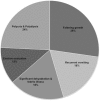Long-term outcome in inherited nephrogenic diabetes insipidus
- PMID: 30976394
- PMCID: PMC6452213
- DOI: 10.1093/ckj/sfy027
Long-term outcome in inherited nephrogenic diabetes insipidus
Erratum in
-
Erratum: Long-term outcome in inherited nephrogenic diabetes insipidus.Clin Kidney J. 2020 Dec 7;13(6):1111. doi: 10.1093/ckj/sfaa223. eCollection 2020 Dec. Clin Kidney J. 2020. PMID: 33391759 Free PMC article.
Abstract
Background: Inherited nephrogenic diabetes insipidus (NDI) is a rare disorder characterized by impaired urinary concentrating ability. Little clinical data on long-term outcome exists.
Method: This was a single-centre retrospective medical record review of patients with a diagnosis of NDI followed between 1985 and 2017. We collected available data on growth, weight, school performance, complications and comorbidities.
Results: We identified 36 patients with available data and a clinical diagnosis of NDI, which was genetically confirmed in 33 of them. Patients presented at a median age of 0.6 years and median length of follow-up was 9.5 years. Chief symptoms at presentation were faltering growth, vomiting/feeding concerns, polyuria/polydipsia, febrile illness and hypernatraemic dehydration. Median weight standard deviation scores (SDS) improved from -2.1 at presentation to 0.2 at last follow-up. In contrast, height SDS remained essentially unchanged at -1.1 at presentation and -0.9 at last follow-up. Most patients were treated with prostaglandin synthesis inhibitors and thiazides, yet weaned off during school age without an obvious change in urine output. Median estimated glomerular filtration rate at last follow-up was 81 mL/min/1.73 m2. Urological complications were noted in 15 patients, constipation in 11 and learning difficulties in 5. Median age at resolution of nocturnal enuresis was 11 years. Estimated median daily fluid intake at median age of 13 years was 3800 mL/m2.
Conclusion: The overall prognosis in inherited NDI is favourable with regular treatment. As expected, most complications were related to polyuria. There is an apparent loss of efficacy of medications during school age. Our data inform the prognosis and management of patients with NDI.
Keywords: AQP2; AVPR2; congenital nephrogenic diabetes insipidus; hypernatraemia; polyuria.
Figures


References
-
- Bockenhauer D, Bichet DG.. Pathophysiology, diagnosis and management of nephrogenic diabetes insipidus. Nat Rev Nephrol 2015; 11: 576–588 - PubMed
-
- Bockenhauer D, Bichet DG.. Inherited secondary nephrogenic diabetes insipidus: concentrating on humans. Am J Physiol Renal Physiol 2013; 304: F1037–F1042 - PubMed
-
- Bichet DG, Razi M, Lonergan M. et al. Hemodynamic and coagulation responses to 1-desamino[8-D-arginine] vasopressin in patients with congenital nephrogenic diabetes insipidus. N Engl J Med 1988; 318: 881–887 - PubMed
-
- Bichet DG, Bockenhauer D.. Genetic forms of nephrogenic diabetes insipidus (NDI): vasopressin receptor defect (X-linked) and aquaporin defect (autosomal recessive and dominant). Best Pract Res Clin Endocrinol Metab 2016; 30: 263–276 - PubMed
-
- Hoekstra JA, van Lieburg AF, Monnens LA. et al. Cognitive and psychosocial functioning of patients with congenital nephrogenic diabetes insipidus. Am J Med Genet 1996; 61: 81–88 - PubMed
LinkOut - more resources
Full Text Sources
Research Materials

